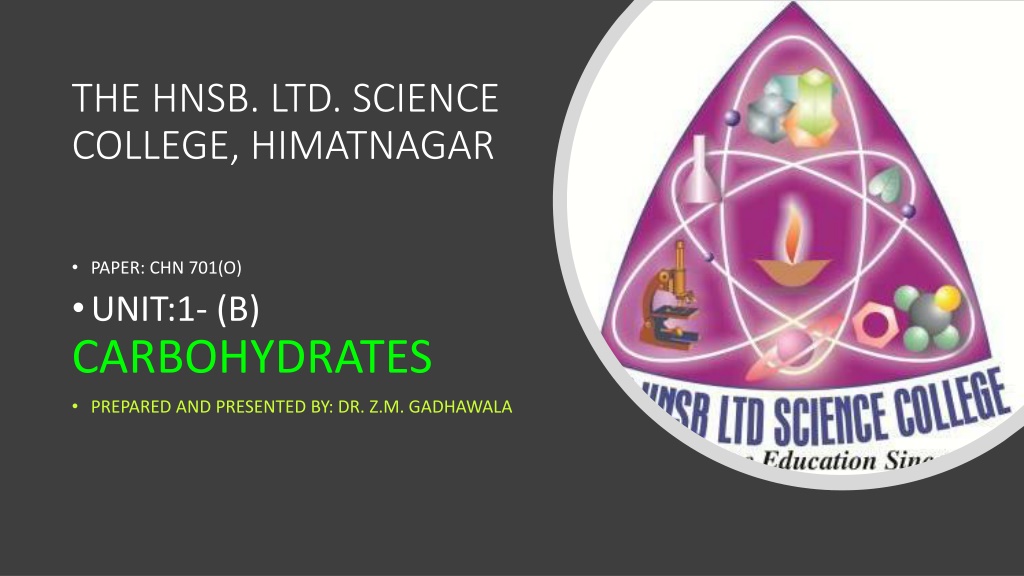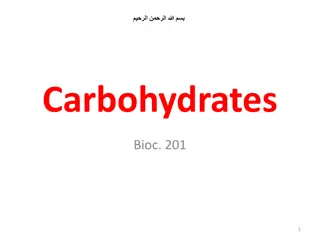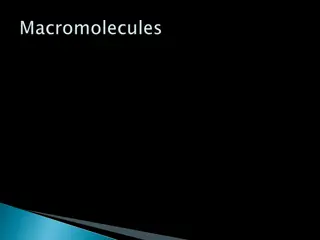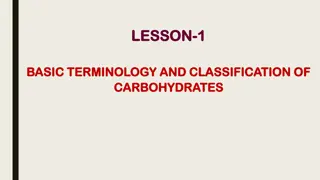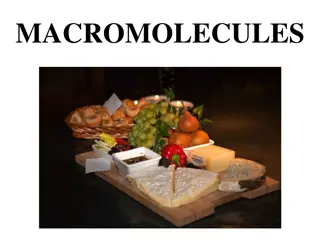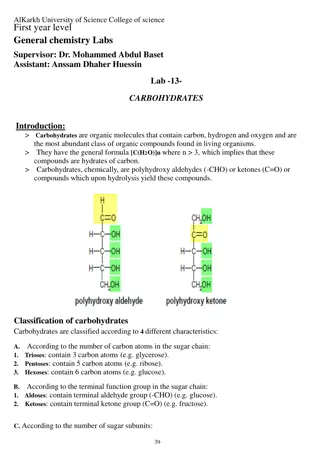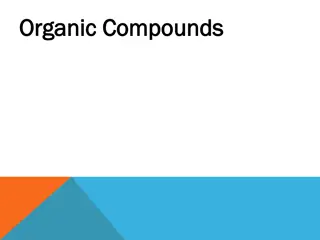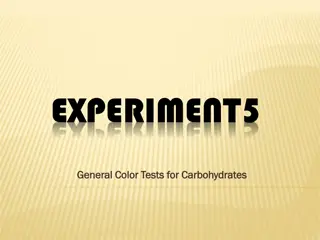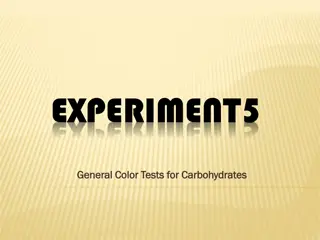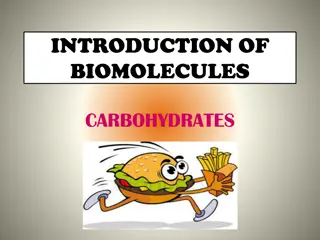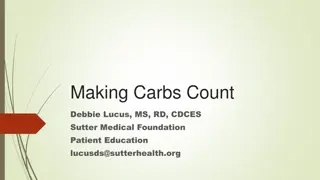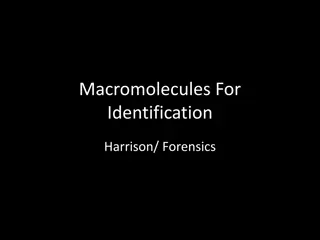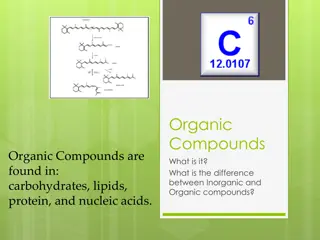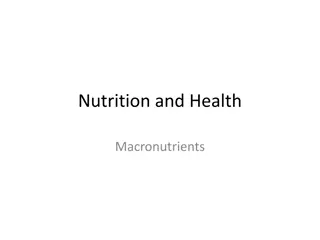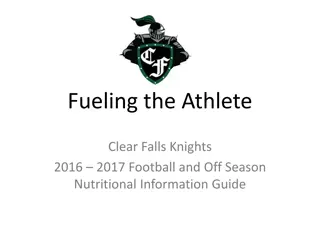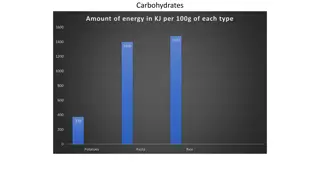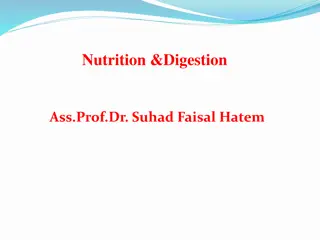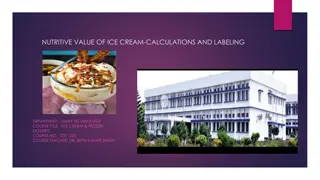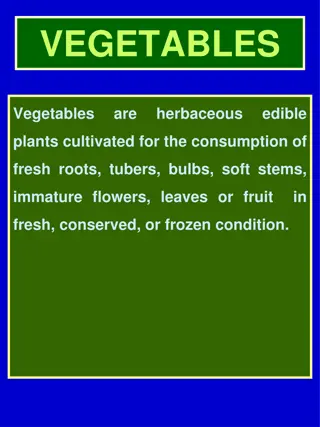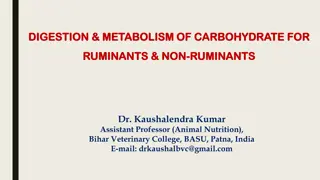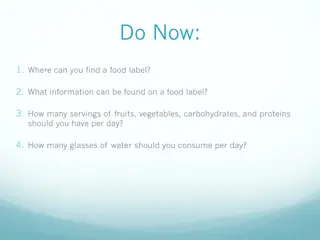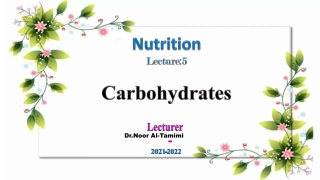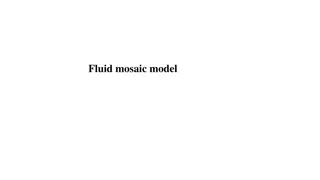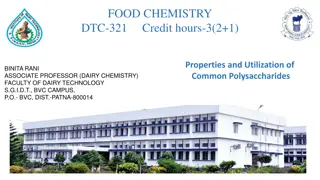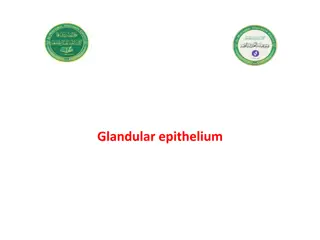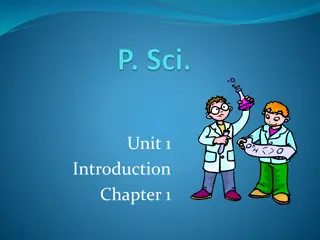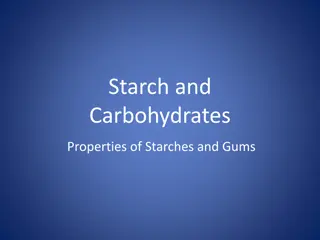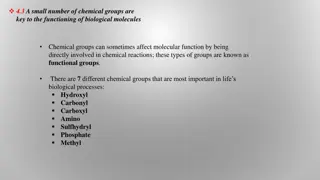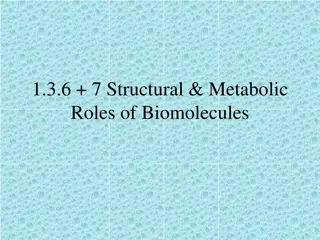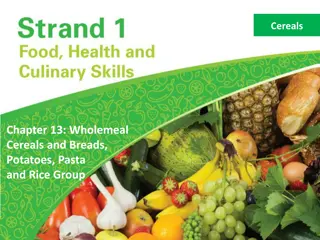Understanding Carbohydrates in Science: Structure, Types, and Applications
Explore the comprehensive study of carbohydrates, including their types such as monosaccharides, disaccharides, and polysaccharides. Learn about the molecular structure and functions of cellulose, starch, and other key carbohydrates. Delve into the chemistry of sugars, nucleic acids, and protein synthesis. Discover the significance of carbohydrates in various biological processes and industries through detailed explanations, images, and references provided in the content.
Uploaded on Sep 21, 2024 | 0 Views
Download Presentation

Please find below an Image/Link to download the presentation.
The content on the website is provided AS IS for your information and personal use only. It may not be sold, licensed, or shared on other websites without obtaining consent from the author. Download presentation by click this link. If you encounter any issues during the download, it is possible that the publisher has removed the file from their server.
E N D
Presentation Transcript
THE HNSB. LTD. SCIENCE COLLEGE, HIMATNAGAR PAPER: CHN 701(O) UNIT:1- (B) CARBOHYDRATES PREPARED AND PRESENTED BY: DR. Z.M. GADHAWALA
SYLLABUS Type of Naturally occurring Sugars, Deoxy sugars, Amino sugars. General method of structure and ring size determination with reference to Starch and Cellulose Photosynthesis of Carbohydrates. Purine & Nucleic Acid :- Chemistry of Uric Acid, Adenine, Caffeine Structure of Nucleotides, Nucleosides, DNA, RNA and Conformations, Protein synthesis, Perbiotic Chemistry.
Reference Books Organic Natural Products by O.P. Agrawal
COs To enable students about the knowledge of amino sugar, deoxy sugar, polysaccharide like cellulose and starch, photosynthesis of carbohydrates,
Definition of Carbohydrates M.F.: Cx (H2O)y Having functional group like hydroxyl, aldehyde or ketone = carbohydrate H:O = 2:1
Examples of carbohydrates:(Mono Saccharide) Triose: C3H6O3 Tetrose: C4H8O4 Pentose: C5H10O5 Hexose: C6H12O6
Disaccharide Sucrose: Maltose:
Lactose: Cellobiose:
Polysaccharide Cellulose: Starch:
CELLULOSE: Cellulose is a chief compound of wood & plants fibers Cotton is a 100% pure Cellulose. It is insoluble in water & tasteless. It is non reducing carbohydrate. The Cell wall of plants cell is made from Cellulose. Like body skeletal of man, the structure of plant is made from Cellulose. USES : It is useful for making of different types of clothes, chemicals, papers, film and rayon
Constitution of Cellulose: M.F.:[C6H10O5]n Present groups: Acidic hydrolysis Cellulose n Glucose (96%) No. of D(+) Glucose unit = 100 to 200 Polysaccharide M.W. = 20000 to 40000 gm/mole
Acetylation Triacetoxy cellulose Methylation Cellulose Trimethoxy cellulose Nitration Trinitro Cellulose 3 OH present in each glucose unit
Methylation Cellulose Methylated cellulose Hydrolysis 2,3,6-tri methoxy D(+) Glucose + 2,3,4,6-tetra methoxy D(+) Glucose Hydrolysis Glucose Methylated Glucose Methylation
Glucose units joint C1-C4 linkage Glucose units Pyranose cycle on C2,C3 & C6 3 OH 2,3,4,6-tetra methoxy D(+) Glucose C1 OH & 2,3,6-tri methoxy D(+) Glucose C4 OH
Cellulose have no. of Cellobiose units
S.F. of Cellulose
Starch Sources : From maize, beat, rice, wheat, and potato's tumor It is insoluble in cold water. Its make a paste with hot water. Uses : It is used as a sizing material in paper industries, Finishing agent in textile industries, and Calico printing. It is also used in laundries for finishing of clothes. It is also used for manufacture of glucose, alcohol, dextrin, & explosives. It is also used as a indicator in Kinetic titration. Starch contain 20 % water soluble fraction called Amylose & 80 % water insoluble fraction called Amylopectin.
Constitution of Starch M.F.:[C6H10O5]n Present groups: Acidic Hydrolysis Starch No. of D(+) Glucose unit = 300 to 350 n D(+) Glucose 97% Polysaccharide M.W. = 15000 to 60000 gm/mole
methylation Complete Starch methylated starch Maltose hydrolysis enzyme Hydrolysis methylation Starch n Maltose octamethoxy maltose Hydrolysis 2,3,6-trimethoxy D(+) glucose+ 2,3,4,6-tetra methoxy D(+) Glucose
Structure of Maltose M.F. : C12H22O11 Present Groups: Maltose phenyl hydrazone Maltose Malt bionic acid
Methylation Maltose Octa methoxy Maltose Hydrolysis 2,3,6-tri methoxy D(+) Glucose + 2,3,4,6-tetra methoxy D(+) Glucose Hydrolysis Methylation Glucose Methylated Glucose
General Information of Alpha & Beta Amylose Starch contain 20 % alpha Amylose & 80 % beta Amylose. When we add n Butanol in hot solution of Starch and allow to stand at room temperature and filter it then we will get PPTs of alpha Amylose and filtrate contain beta Amylose. I2 is added in the hot solution of alpha Amylose then it gives blue color and I2 is added in the hot solution of beta Amylose then it gives violate color. Enzymatic hydrolysis of alpha Amylose gives Maltose While enzymatic hydrolysis of beta Amylose gives 62 % Maltose and 38 % Amylopectin. The structure of alpha Amylose has linear structure and beta Amylose has branched structure.
Constitution of - Amylose M.F. :[C6H10O5]n Hydrolysis: Acidic & Enzymatic M.W. = 50000 gm/mole Acidic Hydrolysis indicates that 300 350 Glucose units are present. Enzymatic Hydrolysis indicates that in alpha Amylose no. of Maltose units having glucose are present. Maltose is 4- O- D- GlucoPyranose @ Pyranose Cycle & C1-C4 linkages Hydrolysis n D(+) Glucose (C6H10O5)n Hydrolysis n Maltose (C6H10O5)n Enzymatic
Methylation: Reaction : - Amylose Methylated Amylose (CH3)2SO4/NaOH dil HCl/H-OH Methylation + 2,3,4,6-tetra methoxy D(+) Glucose 2,3,6-tri methoxy D(+) Glucose @ Pyranose Cycle @ C1-C4 linkages @ Linear structure
Constitution of - Amylose (Amylopectin) M.F. :[C6H10O5]n Hydrolysis: M.W. = 50000 to 1000000 gm/mole Average M.W = 550000 gm/mole @ 3000 Glucose units are present. Oxidation: Oxidation with HIO4 it gives formic acid. It is possible when 24-27 D(+) Glucose units are present in linear chain & then after one branch of non reducing group is present. Hydrolysis n D(+) Glucose (C6H10O5)n
Methylation: Reaction : Amylopectin Methylated Amylopectin Methylation Hydrolysis Pyranose Cycle Branched structure 120 branches + 2,3-dimethoxy D(+) Glucose 2,3,4,6- tetra methoxy D(+) Glucose 2,3,6- tri methoxy + D(+) Glucose
Enzymatic Hydrolysis : Diastase Amylopectin 1,6 alpha linked di Glucose (32%) + Maltose (62%) In Maltose Glucose units joint with each other in linear chain (main chain) with C1-C4 linkages and in Iso maltose Glucose units joint with each other with C1-C6 linkages(branches chain)
